|
sito + "/AREA=" + sezione + "/AAMSZ=" + misura + "/ACC_RANDOM=" + bumber + "/PAGEID=" + pageid + "'>"); document.write(""); |
| home > allestimenti |
|
sito + "/AREA=" + sezione + "/AAMSZ=" + misura + "/ACC_RANDOM=" + bumber + "/PAGEID=" + pageid + "'>"); document.write(""); |
| home > allestimenti |
| Installing
Liquid Stone Billie Tsien, Jennifer Turner |
||||
| In
an age when architects aspire to an ever increasing immateriality and
lightness in construction, it is significant that the National Building
Museum in Washington DC is hosting a series of ongoing exhibitions that
explore the design and cultural implications of specific building materials:
wood, stone and, the latest, concrete. As if to remind us that materiality,
after all, is one of the fundamental elements of architecture. All this
is achieved in a very thoughtful and inventive way by the exhibit curator,
Martin Moeller, who skillfully avoids a historical survey of the architectural
uses of concrete while focusing on a series of innovative and experimental
contemporary projects. Tod Williams and Billie Tsien are known to the
international public for their rigorous and delicate intervention at
the Neuroscience Institute in La Jolla, next to Kahn's Salk Institute,
and for the more recent Natatorium at Cranbrook Academy and the Museum
of American Folk Art in New York City. As architects in charge of the
Liquid Stone exhibit design, they put a very clear and distinctive idea
in practice: they employed the basic components of concrete (panels
and rebars) in order to create a meditative and unifying landscape,
a muted backdrop that offers the visitor a contemplative atmosphere
to appreciate the starkly beautiful photographs, models and artifacts
arranged through the enfilade of the museum's galleries. Martin
Moeller, curator of the exhibit, and Billie Tsien with Jennifer
Turner of Tod Williams Billie Tsien Architects present for ARCH'IT their
integrated effort in producing this attractive exhibit: a fruitful collaboration
to be hoped for. [PG] |
||||
| We
were asked by the curator, Martin Moeller, to be the designers of the
show Liquid Stone at the National Building Museum. Concrete,
as the name of the show implies, is a material that takes many forms.
It was the curator's premise that the show be divided into four primary
sections. After an introduction consisting of a historical survey, a
"cookbook" recipe for concrete, and a clear description of the physical
characteristics of concrete, the installation is separated into STRUCTURE,
SURFACE, SCULPTURAL FORM, FUTURE. |
[25oct2004] | |||
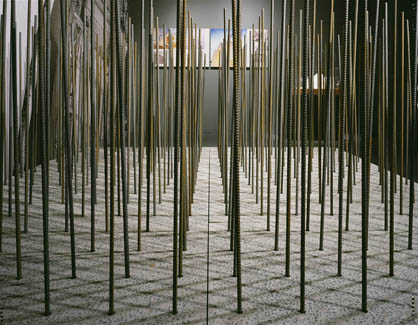 Rebar reeds. Photo: Frank Oudeman. The National Building Museum occupies a building of grand scale constructed in 1887 to house the Pension Bureau. Thus, the spaces were never meant to be used as galleries. The exhibit consists of a series of vaulted rooms (like beads on a string) which are entered en filade and not immediately visible from the massive lobby. Our greatest challenge in designing the show was to create a sense of unity in this divided space. |
||||
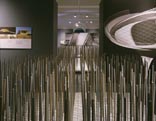 Sculptural form galleries. Photo: Frank Oudeman. 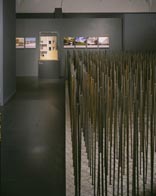 Structure gallery. Photo: Frank Oudeman. |
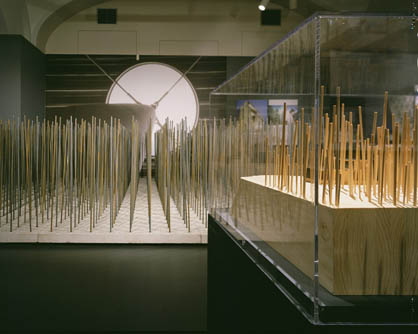 Structure gallery and mural. Photo: Frank Oudeman. Our first thoughts were to try to make portals that announced the four divisions. Each portal would be cast of light weight concrete and be representative of that particular section. We discarded this idea because it seemed too literal. It also seemed to create problems with lighting and exacerbate the cellular nature of the galleries. |
 Elevation rendering by Pure + Applied (graphic designers). |
||
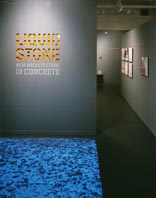 Entry projection. Photo: Frank Oudeman. |
 One of the translucent concrete paneals in the Future gallery. Photo: Pure + Applied. So we came to the idea of using pre-cast squares of terrazzo-ground concrete punctured by evenly spaced vertical steel reinforcing bars (known as rebars). The idea was to create a quiet and unifying landscape of "reeds in sand" using the components of concrete construction. These "planes of landscape" sometimes extend through the passageway from one gallery space into the next. They also act as a determinant of movement, sometimes pushing the visitor to the edges of the space, sometimes filling a whole room so no one can enter. Independently they alluded to and celebrated an absolutely essential element of concrete as it has been used since the 1800's: the steel reinforcing which, though encased, gives the material its tensile strength. |
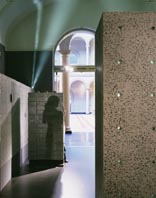 Future gallery w/ LiTraCon translucent concrete. Photo: Frank Oudeman. 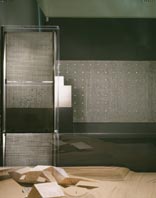 Future gallery w/ pixilated translucent concrete. Photo: Frank Oudeman. |
||
 Test of light behind typical concrete panel for Future gallery concrete panels walls. Photo: Jennifer Turner. 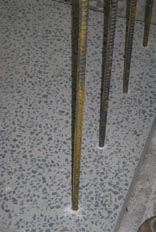 Test of rebar in typical concrete panel. Photo: Jennifer Turner. |
 Sculptural form galleries and tech station. Photo: Frank Oudeman.  Exhibit design. Plan. Working with Urshula Barbour and Paul Carlos of the graphic design firm Pure + Applied, we kept the colors of the walls and floors to a calm palette of grey. All graphic panels were composed of a single color image and several images black and white images. In each section, one image was blown up to mural size to denote the different characteristic. All wall text was printed in a fluorescent orange inspired by the color of the protective plastic caps usually seen on the ends of rebar. The lighting of the show was kept low by omitting ambient lights and using spots only on the objects and panels. The hope was to produce interesting shadows with the "reeds" and create a contemplative atmosphere. In addition, projection was used in two areas to reinforce the space's meditative quality. In one room, the visitor stands immersed in a field of orange capped rebar and takes in shifting images, accompanied by music, of various concrete structures. In the entrance, there is a white panel painted on the floor with a continuous loop of pouring concrete projected on it. The effect is one of a watery moving surface: Liquid Stone. Billie Tsien, Jennifer Turner (Tod Williams and Billie Tsien Architects) |
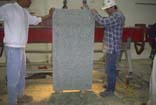 Prototypical concrete panel with rebar holes. Photo: Jennifer Turner. |
||
|
The work of Tod Williams Billie Tsien Architects addresses different worlds. Primarily as practioners, but also as teachers, they move between the academic and built worlds. Their work has both collaborated with and housed the arts. Together, Williams and Tsien have produced works with artists such as Jackie Ferrara, Mary Miss and Elyn Zimmerman. Their built work, bordering on minimalism, pays careful attention to context, to detail and to the subtleties of a subdued but rich materiality. The Neurosciences Institute, completed in 1995, incorporates laboratories, a theoretical studies building and a chamber music auditorium, all aspects of this project including furniture and landscape were designed by the studio. This project was termed a "magnificent piece of work" by New York Times Architecture critic, Herbert Muschamp, and was cited by Time magazine as one of the best designs of '96. The Neurosciences Institute has been widely published, and has received a number of awards, including an AIA National Honor Award. The Cranbrook Natatorium, completed in the fall of 1999 is a building for a competitive swimming pool on the Eliel Saarinen designed campus of the Cranbrook School in Michigan. The Natatorium has been designed in concert with the natural conditions and the landscape. This building breathes with the environment. through twenty foot tall wooden louver doors and two thirty foot oculi which open to the sky. This project has also been awarded a National AIA Award. A new 35,000 square foot building for the Museum of American Folk Art in New York City was completed in December 2001. Critically acclaimed, its attendance has exceeded all expectations. Newsweek magazine called it "elegant, intricate and memorable" saying that it was a "jewel, a brilliant emblem for this historical moment." It was awarded the Arup World Architecture award for Best Building in 2002. Both architects maintain active teaching careers parallel to their practice. They have taught at the Cooper Union, Parsons School of Design, SCI-ARC, Harvard, Yale, University of Texas at Austin and the University of Michigan. In 2003 they shared the Louis I. Kahn chair at Yale University. Billie Tsien is on the boards of the Architectural League, the Public Art Fund, the American Academy in Rome and the Lower Manhattan Development Corporation. Tod Williams is on the advisory board of the School of Architecture at Princeton. |
||||
|
Liquid Stone:
New Architecture in Concrete |
||||
|
>
ALLESTIMENTI: MARTIN MOELLER |
||||
|
La
sezione Allestimenti laboratorio
|